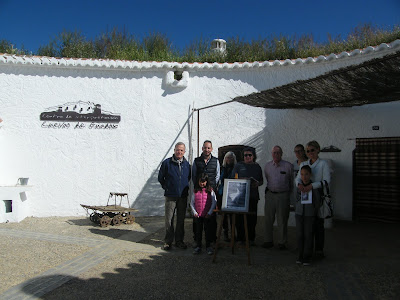 |
| Morgan Smith |
It’s curious because it’s a custom that we don’t celebrate in the United States. In fact, the clothing of the penitents has a totally different feeling in my country than in Spain. Here it is a symbol of the Ku Klux Klan, a dangerous racist group. Therefore, when we visited Caravaca de la Cruz in Murcia during Semana Santa in 1999 – our first Semana Santa – we felt a great shock at seeing the penitents dressed in white leaving the Cathedral.
But immediately we understood that this was something totally different with a sense of beauty, tradition and emotion that had a great effect on us, even though we are not Catholics.
To see the processions in Guadix was a matter of good luck, not something that was planned. What happened in 2006 is that I was traveling alone, passed through Guadix on Easter Sunday and discovered what is the most beautiful of all the processions I have seen - the procession of Hermandad de Cristo Resucitado y Nuestra Señora de la Victoria.
We have had the experience of Semana Santa in many other cities and towns – Sevilla, Granada, Valladolid, Lorca, Caravaca de la Cruz, Baeza, Jerez de la Frontera, Ronda, Sanlúca de Barrameda – but Easter Sunday is the most beautiful and emotional. The light, the colors, the saetas of Andrés Robles, “El Minuto,” the penitents of all ages, the music, especially the cornets, and the sense of reverence and solemnity.
We have been seven times and hope to continue what is, for us, a very important tradition. I want to thank all the participants from Guadix who have continued this very special tradition.
Morgan Smith
‘Freelance’ writer & photographer
Santa Fe—New Mexico (USA)
Brotherhood History
On February 11th,1989, the Blessing-Enthronement of the Image of the Jesus Christ
 |
| Photo: (c) Morgan Smith |
Resurrected, which was acquired by the Fossor Brothers of Mercy, took place to process the Easter Sunday from the Chapel of the Fossor Brothers of Mercy (Graveyard of St. José de Guadix).
The Brotherhood of the Jesus Christ Resurrected and Our Lady of Victory was founded in 1991. In the seventeenth century there was a brotherhood with the same name that worshiped an image that was in the church of Santa Ana (Guadix).
The image is acquired by the Federation of Brotherhoods in the Christian Art Workshops of Olot (Girona), whose blessing took place in Lent in 1989.
 |
Photo: (c) Morgan Smith
|
Since then, his Canonical Seat has been located in the Chapel of the Order of the Fossor Brothers of Mercy in the Cemetery of Saint José (Guadix).
The current image is the work of the sculptor Ventura Gómez Segura, processionando for the first time in 2015.
The image of Ntra. Sra. of the Victory, it is a carving of candlestick for dress made by the imager Luis Sergio Torres, and blessed in 2006.
It processes on step of goldsmithing without pallium realized in the workshops Orovio de la Torre (Ciudad Real).
For more information: Blog: resucitadoyvictoria.blogspot.com.es
“Through the narrow alley come
Strange unicorns.
From what field?
From what mythological forest?
Closer,
Now they seem like astronauts.”
Federico García Lorca,
Poem of the Saeta—Procession-
(Cante Jondo , 1921)
PHOTOS OF THE TEMPORAY EXHIBITION:
 |
“Camareras” praying before of the procession. 2010. (c) Morgan Smith
|
 |
| The feel of the music. 2016. (c) Morgan Smith |
 |
| Help, hope.2010. (c) Morgan Smith |
 |
| Penitents at the exit of the cementery.2006. (c) Morgan Smith |
 |
| Andrés Robles,
“El minuto” singing a “saeta” .2006. (c) Morgan Smith |
 |
| Our
Lady of Victory with a special light . 2016. (c) Morgan Smith |
 |
| Penitents of Cristo Resucitado. 2006. (c) Morgan Smith |
 |
| Our Lay of Victory.arrives 2016. (c) Morgan Smith |
 |
| Different but one same feeling, devotion. 2010 (c) Morgan Smith |
 |
| Costaleras next to Virgen de la Victoria. 2010. (c) Morgan Smith |
 |
| Our Lady of Victory (c) Morgan Smith |
 |
Looking at the sky. 2010. (c) Morgan Smith
|
 |
Wordless
to see Resucitado going out the door of
the cementery. 2010. (c) Morgan Smith
|
Photos of the exhibition introduction :





















































